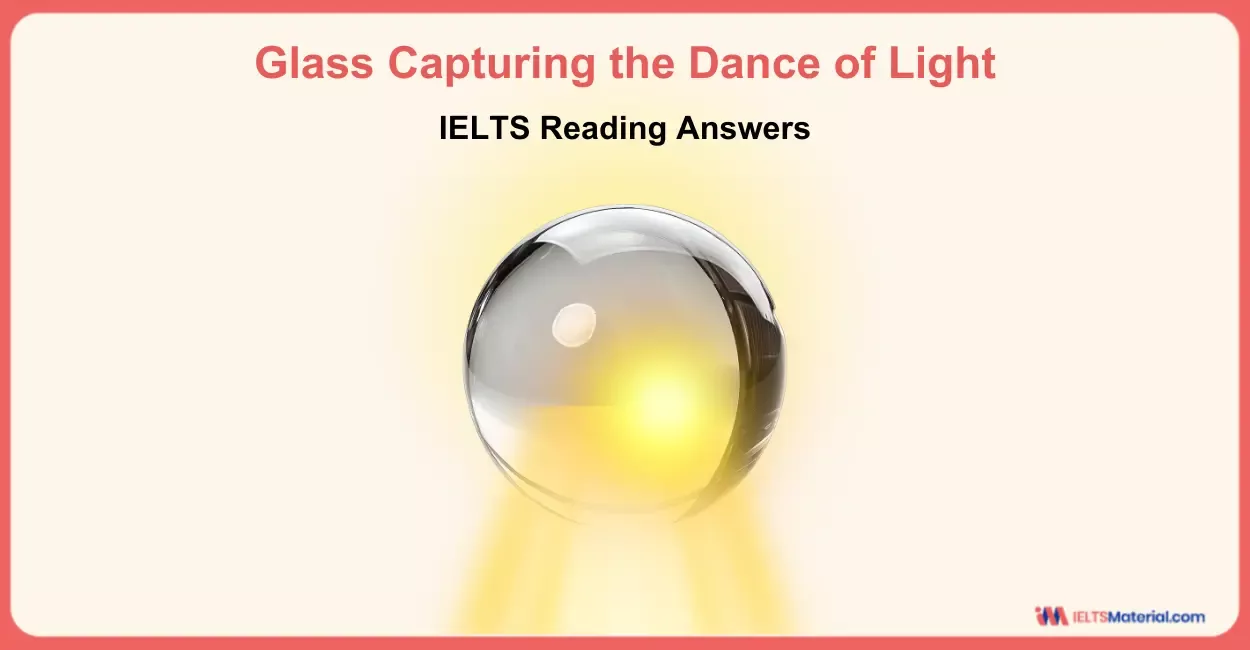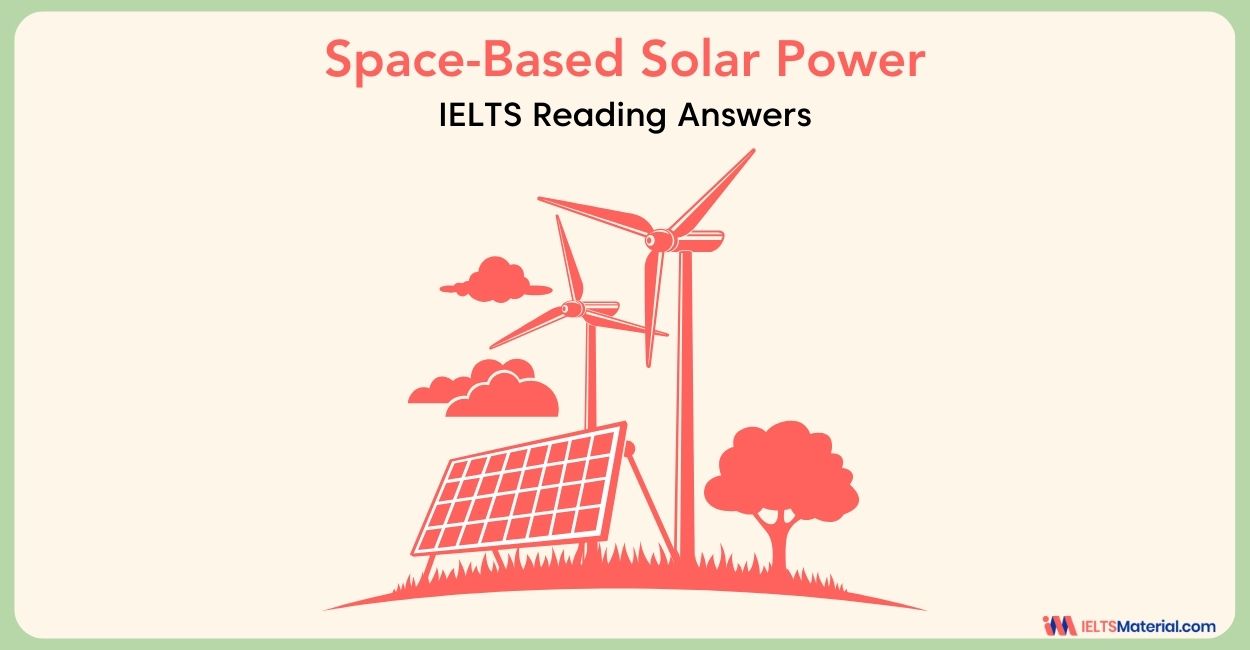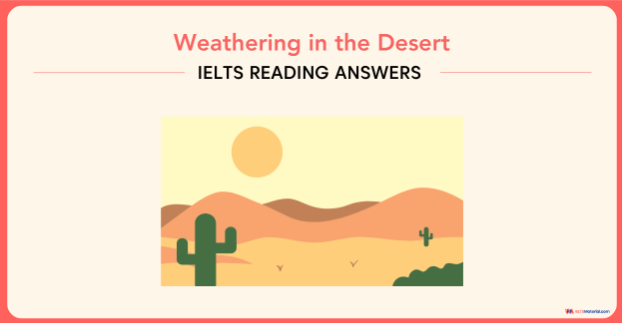Weathering in the Desert – IELTS Reading Answers
Prepare yourself for the IELTS Reading Academic passage on ‘Weathering in the Desert’ along with answers for matching information and true, false, not given question types, where incorporating band 8+ strategies will help achieve a higher band score.
Table of Contents

Limited-Time Offer : Access a FREE 10-Day IELTS Study Plan!
Weathering in the Desert is a passage under the Reading Module where you will find different question types. To achieve a band 8+, you need to practice different topics so that you can enhance your reading skills. By solving and reviewing the reading questions given in the passage, you can identify the areas which you need to work on.
As you prepare with the IELTS Reading passage on ‘Weathering in the Desert’, it is crucial to develop time management skills. This is because you need to answer all 13 questions within 20 minutes. Therefore, it is ideal to put the timer on in order to simulate the exact exam conditions. By practising diligently with a strategic plan, you are one step away from getting your desired scores.
Let’s get started now!
Connect with our band 9 IELTS Trainers to crack your IELTS Reading in no time! Book a FREE Demo.
Types of Questions in Weathering in the Desert IELTS Reading
Before attempting the questions given on the IELTS Academic Reading passage, Weathering in the Desert, you need to know the question types you will answer. Don’t just look at the questions and answers since that might not help in enhancing your skills. Instead, you can focus on getting familiar with the specific question type and the skills needed in order to answer that. Later, you can dive into the passages since you will get an opportunity to check your progress.
The question types found in this passage are:
- IELTS Reading Matching Information(Q. 1-7)
- IELTS Reading True False Not Given (Q. 8-13)
Tips to Solve Questions in Weathering in the Desert
Before you start answering the questions given in the academic reading passage, ‘Weathering in the Desert’, it is crucial to strategically understand how to approach them. In the IELTS Exam, you will be assessed based on your ability to skim for structure, scan for keywords, and comprehend the information. The following are some tips which can guide you to solve the questions given in the passage and find the answer easily.
- In Matching Information type of questions, understanding the overall context of the paragraphs would help you in identifying the correct matches.
- Always read the instructions given for each question type. Every time there is a different question, you need to read these carefully, since they will vary.
- Remember that Time Management for IELTS Reading plays a pivotal role in scoring a higher band. Therefore, you need to practice the passages with a stopwatch so that you can also check the time you are taking to answer the questions.
- Rather than reading the entire passage first, you can go through the question and then scan the text to find specific information corresponding to each statement.
- The answers are given in chronological order. In case you are not able to find an answer for true, false, and not given types of questions, you need to move on to the next question. You can always come back and attempt it later, since you will know which area in the passage you will get it.
- The questions or statements will be paraphrased where synonyms would be used. Therefore, you need to know How to Ace IELTS Reading with 'Keyword Technique' so that you can spot the specific word in the passage.
- Do not assume your answer just based on the keywords but read the entire sentence and understand the context surrounding it.
- Always keep some time to check your answer so that you can rectify any mistakes. Also, note the progress level by comparing your response with the correct reading answers so that you can note the areas of improvement.
- Since the answers are provided with the location and explanation, analyze them so that you can avoid making the same mistakes again.
Do you want to learn how to improve reading skills in IELTS? Check out the video below!
IELTS Reading Passage on Weathering in the Desert
You are advised to spend about 20 minutes on Questions 1-13 which refer to Reading Passage below.
Weathering in the Desert
- In the deserts, as elsewhere, rocks at the earth’s surface are changed by weathering, which may be defined as the disintegration of rocks where they lie. Weathering processes are either chemical, when alteration of some of the constituent particles is involved; or mechanical, when there is merely the physical breaking apart and fragmentation of rocks. Which process will dominate depends primarily on the mineralogy and texture of the rock and the local climate, but several individual processes usually work together to the common end of rock disintegration.
- The great daily changes in the temperature of deserts have long been supposed to be responsible for the disintegration of rocks, either by the differential heating of the various rock-forming minerals or by differential heating between the outer and inner parts of rock masses. However, both field observations and laboratory experiments have led to a reassessment of the importance of ’ exposure to the sun’s rays in desert weathering. Almost half a century ago Barton remarked that the buried parts of some of the ancient monuments in Egypt were more weathered than were those parts fully exposed to the sun’s rays, and attributed this to the effects of water absorption below the ground surface. Laboratory experiments have shown that rocks subjected to many cycles of large temperature oscillations (larger than those experienced in nature) display no evidence of fissuring or fragmentation, as a result. However, when marked fluctuations of temperature occur in moist conditions small rock fragments quickly form.
- The expansive action of crystallizing salts is often alleged to exert sufficient force to disintegrate rocks. Few would dispute that this mechanism is capable of disrupting fissile or well-cleaved rocks or rocks already weakened by other weathering agencies; wood is splintered, terracotta tiles disintegrated and clays disturbed by the mechanism, but its importance when acting upon fresh and cohesive crystalline rocks remains uncertain.
- Weathering achieves more than the disintegration of rocks, though this is its most important geomorphic effect. It causes specific landforms to develop. Many boulders possess a superficial hard layer of iron oxide and/or silica, substances that have migrated in solution from the inside of the block toward the surface. Not only is the exterior thus case-hardened but the depleted interior disintegrates easily. When weathering penetrates the shell the inside is rapidly attacked and only the hard outer layer remains to give hollowed or ‘tortoiseshell’ rocks.
- Another superficial layer, the precise nature of which is little understood, is the well-known desert varnish or patina, a shiny coat on the surface of rocks and pebbles characteristic of arid environments. Some varnishes are colorless, others light brown, yet others so dark a brown as to be virtually black. Its origin is unknown but is significant, for it has been suggested that the varnish grows darker with the passage of time; obviously, before such a criterion could be used with confidence as a chronological tool its origin must be known with precision. Its formation is so slow that in Egypt, for example, it has been estimated that a light brown coating requires between 2,000 and 5,000 years to develop, and a fully formed blackish veneer between 20,000 and 50,000 years.
- The development of relatively impermeable soil horizons that are subsequently exposed at the surface because of erosion of once overlying, easily eroded materials, which thus become surface crusts, is widespread in arid regions, although it is also known outside the deserts, and indeed many of the examples in arid lands probably originated in former periods of humid climate. The crusts prevent the waters of occasional torrential downpours from penetrating deeply into the soil, and thus they contribute to the rapid runoff associated with desert storms. Also, after erosion has cut through the crust and exposed underlying soil layers, the hard layer forms a resistant capping (duricrust) on plateaux and mesas, such as are common in many parts of arid and semi-arid Australia.
- Some duricrust layers have been used as time markers for landforms and geological formations. The necessary conditions for this are that the crust forms fairly rapidly and that it is sufficiently distinct in appearance to preclude the possibility of confusion with other crusts formed at other times. The Barrilaco calcrete of Mexico for instance is believed to date from about 7,000 B.C. The main silcrete of the northern districts of South Australia is believed to date from the Lower Miocene, the laterite of northern Australia to be of the Lower or Middle Miocene age.
Questions 1-7
Reading Passage has seven sections, A-G.
Which paragraph contains the following information?
Write the appropriate letter, A-G, in boxes 1-7 on your answer sheet.
- The idea that crystalline salts may not disintegrate solid rock as easily as other substances
- The fact that daily temperature changes cause rocks to weather may not be as important as supposed
- The regions where weathering creates a thick layer of earth that water cannot penetrate easily
- The fact that weathering not only breaks down rocks, but also shapes the landscape
- The idea of using impenetrable layers of earth to measure chronology
- The two different kinds of weathering in rocks
- The possibility of using the colour of the shiny surface on rocks to measure chronology
Questions 8-13
Do the following statements agree with the information given in the reading passage? In boxes 8-13 on your answer sheet, write
TRUE if the statement agrees with the information
FALSE if the statement contradicts the information
NOT GIVEN if there is no information on this.
- Desert rocks can become weathered when there is a chemical reaction within the rock.
- The parts of Egyptian monuments exposed to sunlight were found to be affected by the weather more than those below the ground.
- Granite which has been subjected to huge temperature swings tends not to exhibit any signs of disintegration as a result.
- It is estimated that dark patina originated between 2,000 and 5,000 years ago.
- Because of surface crusts, water from torrential rains cannot be fully absorbed into the ground and as a result, causes run-offs in arid regions.
- Duricrust layering is no longer used as an indicator of time because of the confusion with similar crusts.
Want to practice more IELTS Reading passages? Grab the IELTS Reading (Academic) Test Guide: Essential Tips, Strategies, and Practice Tests” (April-June 2025).
Answers with Location and Explanation of IELTS Reading Passage - Weathering in the Desert
Have you attempted the questions? Did you use the tips? Now, let’s check out the Weathering in the Desert IELTS reading answers with their location and explanations. Note the question type or any individual questions where you are facing difficulty, so that with consistent practice, you get a higher IELTS Band Score. Now, let's look at the answers given in the table below.
|
Answer |
Question Type |
Answer Location |
Answer Explanation |
|
1. C |
Matching Features |
Paragraph C, first two lines |
The answer is located in the first two lines of paragraph C, “The expansive action of crystallising salts is often alleged to exert sufficient force to disintegrate rocks.” This reference suggests the idea that crystalline salts may not disintegrate solid rock as easily as other substances. |
|
2. B |
Matching Features |
Paragraph B, line 10 |
The answer is Located in lines 9 to 11 in paragraph B, “Laboratory experiments have shown that rocks subjected to many cycles of large temperature oscillations (larger than those experienced in nature) display no evidence of fissuring or fragmentation”. This reference suggests that the fact that daily temperature changes cause rocks to weather may not be as important as supposed. |
|
3. F |
Matching Features |
Paragraph F, line 6 |
The answer is located in the 5th and 6th line of paragraph F, “The crusts prevent the waters of occasional torrential downpours from penetrating deeply into the soil”. This reference suggests that the regions where weathering creates a thick layer of earth that water cannot penetrate easily. |
|
4. D |
Matching Features |
Paragraph D, line 1 |
The answer is located in the first line of paragraph D, “Weathering achieves more than the disintegration of rocks,”. This reference suggests that the fact that weathering not only breaks down rocks but also shapes the landscape. |
|
5. G |
Matching Features |
Paragraph G, first 2 lines |
The answer is located in the first 2 lines of paragraph G, “Some duricrust layers have been used as time markers for landforms and geological formations”. This reference suggests the idea of using impenetrable layers of the earth to measure chronology. |
Unlock Explanations
If you want to have a look at the remaining explanations, sign up!
|
6. A |
Matching Features |
Paragraph A, line 3 |
The answer is located in the 2nd and 3rd line in paragraph A, “Weathering processes are either chemical, when alteration of some of the constituent particles is involved; or mechanical,”. This reference suggests the two different kinds of weathering in rocks. |
|
7. E |
Matching Features |
Paragraph E, 5th and 6th lines |
The answer is located in the 5th and 6th line of paragraph E, “..obviously before such a criterion could be used with confidence as a chronological tool”. This reference suggests the possibility of using the color of the shiny surface on rocks to measure chronology. |
|
8. TRUE |
True/ False/ Not Given |
Paragraph A, line 3 |
The answer is located in the 2nd and 3rd line of paragraph A, “Weathering processes are either chemical”. This concludes that “Desert rocks can become weathered when there is a chemical reaction within the rock”. Hence the answer is ‘True’. |
|
9. FALSE |
True/ False/ Not Given |
Paragraph B, line 7 |
The answer is located in the 6th and 7th line of paragraph B, “buried parts of some of the ancient monuments in Egypt were more weathered than were those parts fully exposed to the sun’s rays,” This concludes that “The parts of Egyptian monuments exposed to sunlight were found to be affected by the weather more than those below the ground.” This suggests that the reference is not the same as the statement. Hence the answer is ‘False’. |
|
10. NOT GIVEN |
True/ False/ Not Given |
NA |
As the paragraph D from line 2 to line 5 with the given reference “Weathering achieves more than the disintegration of rocks, though this is its most important geomorphic effect. It causes specific landforms to develop. Many boulders possess a superficial hard layer of iron oxide and/or silica, substances that have migrated in solution from the inside of the block toward the surface. Not only is the exterior thus case-hardened but the depleted interior disintegrates easily.” Since there is no mention of whether granite which has been subjected to huge temperature swings tends not to exhibit any signs of disintegration as a result. Hence the answer is ‘Not Given’. |
|
11. FALSE |
True/ False/ Not Given |
Paragraph E, last 2 lines |
The answer is located in the last 2 lines of paragraph E, “it has been estimated that a light brown coating requires between 2,000 and 5,000 years to develop,”….This concludes that the statement “It is estimated that dark patina originated between 2,000 and 5,000 years ago.” doesn’t match with the given reference in the paragraph. Hence the answer is ‘False’. |
|
12. TRUE |
True/ False/ Not Given |
Paragraph F, lines 5th and 6th |
The answer is located in the 5th and 6th line of paragraph F, “The crusts prevent the waters of occasional torrential downpours from penetrating deeply into the soil, and thus they contribute to the rapid runoff”. This concludes that “Because of surface crusts, water from torrential rains cannot be fully absorbed into the ground and as a result causes runoffs in arid regions.” this is the same as the reference mentioned in the passage. Hence the answer is ‘True’. |
|
13. NOT GIVEN |
True/ False/ Not Given |
Paragraph G, lines 1-4 |
In the mentioned paragraph G, from lines 1-4 in the given reference “Some duricrust layers have been used as time markers for landforms and geological formations. The necessary conditions for this are that the crust forms fairly rapidly and that it is sufficiently distinct in appearance to preclude the possibility of confusion with other crusts formed at other times.” There is no mention of whether duricrust layering is no longer used as an indicator of time because of the confusion with similar crusts. Hence the answer is ‘Not Given’. |
Enroll into our Free IELTS Webinar and learn more about techniques to improve your reading speed.
Mastering the reading module requires you to practice diligently while acquiring the needed skills. By practising with passages like this one, ‘Weathering in the Desert ‘, you will be able to achieve a band 8+. Focus on the question type and understand how to approach these questions strategically will strengthen your skills with ease.
Check More Reading Passages
Also Check:
Practice IELTS Academic Reading based on question types

Start Preparing for IELTS: Get Your 10-Day Study Plan Today!
Explore other Reading Practice Tests

Nehasri Ravishenbagam

Nehasri Ravishenbagam

Kasturika Samanta

Kasturika Samanta
Recent Articles

Kasturika Samanta

Nehasri Ravishenbagam

Nehasri Ravishenbagam

Kasturika Samanta




Post your Comments